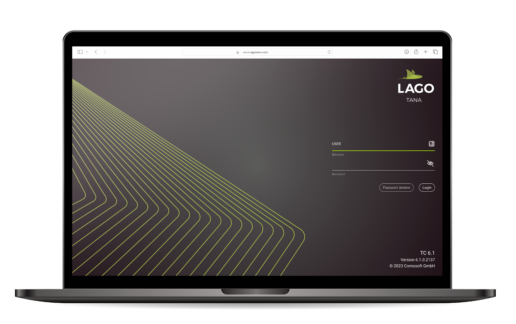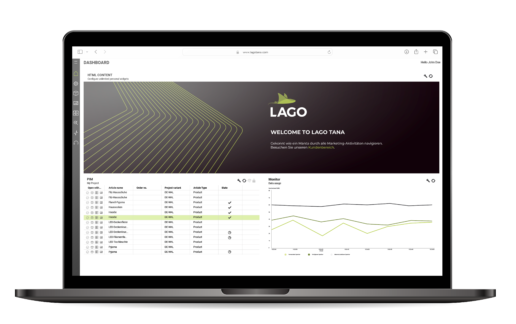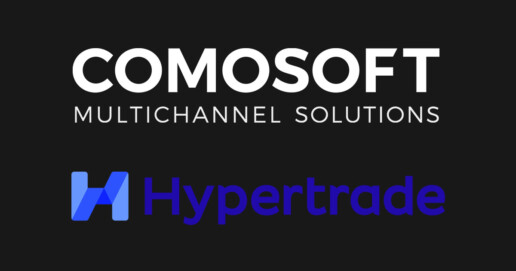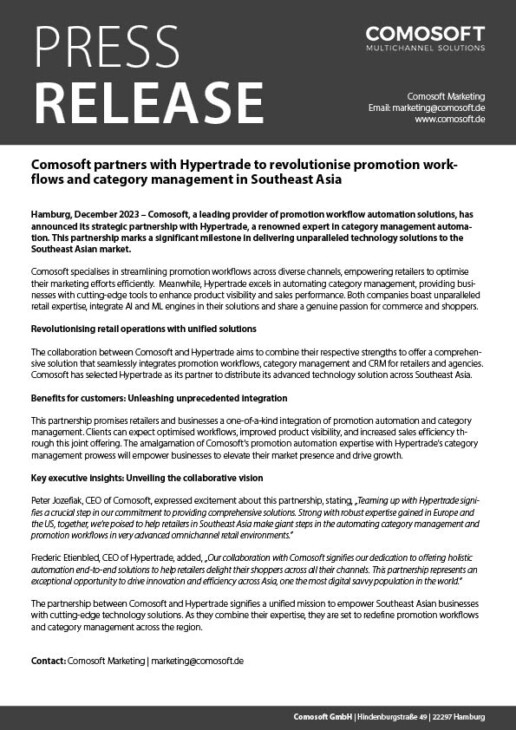5 Retail printing trends you can expect to see in 2024
5 Retail printing trends you can expect to see in 2024
Those claiming that the power of print is waning need only look at the numbers to see how far this is from the truth. Print media is one of the most trusted media channels among consumers, who reportedly trust newspapers and magazines to help make a purchase more than any other type of advertising. In fact, 82 percent of Americans rely on newspaper and magazine advertising as a reliable source.
As a reflection of this trust, the retail print and consumables market is demonstrating significant growth. Looking ahead, the demand for these materials is anticipated to grow between 2023 and 2033 at a compound annual growth rate (CAGR) of 4.5 percent.
Overall, the retail industry is showing signs of growth – and with plenty of innovations in publishing print, retail print marketing is having a moment to carry into the new year.
The U.S. Postal Service recently shared that consumers who receive direct mail from retailers not only purchase 28 percent more items but also spend 28 percent more compared to those who do not receive direct mail marketing materials. Print marketing continues to connect with consumers in fresh, exciting ways. Here are some retail print marketing trends predicted to blaze new trails and lead the way in 2024.
1. A focused effort towards real sustainability
Regarding publishing print marketing materials, retailers are looking for strategies to make their processes more sustainable. This drive toward sustainability includes factors like:
- Limiting carbon footprint and reducing waste production
- Choosing recycled materials for paper, ink cartridges, and other supplies
- Sustainable printers and printing devices
Where is this drive toward sustainability coming from? It’s coming directly from consumers. Recently, an astonishing 84 percent of customers stated that discovering that a brand has poor environmental practices would alienate them from that company – and 55 percent of these customers would even pay more to support an eco-friendly brand than those with less sustainable practices.
Moving into 2024, brands should examine their printing processes to discover how they might make them more sustainable – and how they can share this information with their audience to foster a transparent connection with environmentally-minded consumers.
2. Printing according to demand: Short-run printing
Short-run production and printing on demand are tied closely with a movement toward sustainable publishing. Not only does this limit waste, but it also reduces excess production and costs associated with it. With on-demand printing, retailers are becoming more strategic and printing fewer copies of their printed marketing materials while only producing additional copies as needed.
Short-run printing can be a smarter alternative to larger printing runs when introducing a new product, trying out new content, or even targeting a smaller, niche market with a more focused message. It can also be an effective tool for market research analysis. By including unique promotional codes or QR codes in short-run printing materials, retailers can gather more specific data about how their customers respond to a particular product or marketing initiative.
3. A continued push toward personalisation
Personalised print marketing will continue to be an essential trend moving into 2024 for one primary reason: It works. This highly effective print marketing strategy has proven results. Direct mail print marketing personalised to the recipient generates 135 percent better response rates.
There’s much power in personalisation. Consumers already possess a strong emotional connection to a tangible message they receive and can hold. But when retailers match the impact of direct mail with personalisation through customer data, custom greetings, and product recommendations, it amplifies this connection.
Customers feel valued and prioritised When they get a message from a brand that’s meant specifically for them. Perhaps that’s why 75 percent of millennial-aged consumers share that when they receive personal direct mail, they feel special and there’s something quite powerful in that.
With advances in publishing solutions, personalised printed marketing materials aren’t out of reach. Personalisation can be a simple and affordable way to strengthen relationships between retailers and consumers. It can include customisations for location, industry-based marketing, and even customer retargeting – which was once only financially feasible online.
4. The sensory experience of print
Perhaps one of the most significant assets of a print catalog, magazine, or direct mailer? It’s not online. The typical U.S. consumer will spend a daily average of 4 hours and 25 minutes – or 65 full days – on their phones in 2023. Conversely, Americans keep printed, direct mail advertisements in their home for an average of 17 days – and 41 percent of all Americans look forward to checking the mail daily, most of which consists of advertisements.
A printed catalog is a unique, memorable experience in a world saturated with digital interactions. For this reason, many retailers will continue designing print marketing materials that focus on the tactile experience to interact with consumers’ senses in a way digital media can’t. This strengthens the emotional connection consumers feel toward a particular product or brand.
What do these tactile experiences look like – or rather, feel like? It might be the feel of the paper, with choices like linen or textured paper, or even letterpress printing, engraving, or embossing, raised UV and polymer finishes, or specialty coatings like leather or even paper with a sandy texture. It might also be the added texture, look, and feel of interacting with hand-sewn or high-end binding.
The trend of creating a sensory experience for consumers isn’t limited to the tactile feel of printed materials. Some retailers are looking for ways to reach the other senses, even experimenting with adding scented inks, coatings, and varnishes during the print run. Since the sense of smell connects to emotion and memory, this can be a powerful tool for retailers to delight and surprise their customers and make a lasting impression.
5. Embracing new technologies and augmented realities offline
While not a new trend, including personalized URLs and QR codes to drive customers online and track behavior continues to be popular – but these are not the only ways retailers will leverage technology in their printed marketing campaigns.
Consumers are incredibly excited about the possibility of new technologies like artificial intelligence (AI) and augmented reality (AR); they’re eager to test out these tools and see all the different ways they might be used.
Printed augmented reality features included in these printed campaigns can capture the attention and imagination of consumers, with options to discover a product on the page, then use their phone to get a 360-degree view or detailed look at what this product can do or even how it will look in their home.
AR can enhance the user experience and help customers through their decision-making or buying process by scanning a link on the printed page. It’s important to note that customers in 2023 and 2024 may not be eager to download an app to use these features. Thanks to the introduction of WebAR, however, retailers can still implement AR experiences into their print media.
With WebAR, consumers can access many AR features through their device’s web browser. These web-based AR tools present an incredible opportunity for retailers to build innovative campaigns that merge the digital and physical worlds with interactive content and try-it-before-you-buy-it offers that enrich the entire customer experience in a brand-new way.
Comosoft keeps you ahead of the trends
LAGO by Comosoft is a one-of-a-kind marketing automation tool that revolutionizes the entire collaborative workflow process in real time, making it possible for retailers to store data and digital assets in one secure repository accessible from anywhere. The result is a more efficient publishing process that lets you stay updated on the latest trends. When you manage the entire Digital Asset Management (DAM), Production Information Management (PIM), and publishing process from one place, there’s more time to keep up with the newest innovations.
Comosoft LAGO is an all-in-one marketing production solution fully equipped with both a PIM and DAM solution. It supports your operations with integrated workflow collaboration support, versioning
LAGO TANA Release
LAGO TANA – Explore a whole new version of LAGO!
Improved interface, streamlined features and proven workflows:
With this release Comosoft enters a new era of LAGO versions – Beginning with the name Tana and a new LAGO logo. If you ever happened to have an encounter with a manta ray, our new logo mascot, you met one of the most calm and majestic animals on the planet. The version name Tana refers to the biggest lake in Ethiopia, which is the water mouth of the Blue Nile, and the surrounding prolific reserve.
HIGHLIGHTS
A completely new look and feel of LAGO is a long awaited change and above all reflects the new modern technology behind LAGO TANA. Despite the new UI, LAGO retains the familiar user experience. The most impact will be brought by the flat design and a general brighter appearance of the interface. Calm sections with reduced design elements will help users focus on their tasks.
Better overview, faster access. The new LAGO Dashboard, included in our web client will greet all users upon login and before navigating into one of our various applications.
LAGO Dashboard allows to configure global and personal dashboards. Global dashboards can be shared with user groups to ensure that users of the same group have access to the same information. Optionally users can create their own dashboards. Editing the layout of a dashboard is easily done by simple drag and drop actions.
For the content of the dashboards, various widgets are available, such as a global job list, which allows to directly jump into different application depending on the job (e.g. opening a document directly in LAGO Whiteboard or LAGO Proof). The widget “Search Results”, which is based on search folders contains quick links into the applications (e.g. to directly edit an article shown in a filter). LAGO Dashboard can also be used to distribute information such as announcements or links to other important resources, using the widget “HTML Content”.
For over 20 years, LAGO has been using Adobe Photoshop® to process assets for various use cases, from which the import of assets is the main use case. With more parts of the application moving towards the server and aways from client applications, the usage of Adobe Photoshop® has become challenging for IT departments.
The solution is the LAGO Asset Processor, which is the server-based solution for LAGO Pict with Adobe Photoshop®. LAGO Asset Processor runs on the LAGO Application Server (“LAS”) as a servlet within Apache Tomcat and performs asset processing for import and export purposes without the need of Adobe Photoshop®. It is designed for scalability and allows the setup of multiple instances in multiple Apache Tomcats if needed. It is also possible to assign different tasks to different LAGO Asset Processor instances.
Configuration and management of LAGO Asset Processor is being done within LAGO Admin, where instances, tasks and task configurations (e.g. “Hotfolder” configurations) can be configured. The logging and activity can be viewed within LAGO Monitor. The tasks can be activated and deactivated on the fly without having to restart the LAS.
The LAGO Asset Server within LAGO Pict, including the plugin for Adobe Photoshop® is still available with LAGO TANA. However, asset processing without Adobe Photoshop® is only possible when using the LAGO Asset Processor.
The module “LAGO History” including the corresponding application LAGO History has historically been an application for administrators, which allows to view a history on specific data changes per data entity. For example, showing which user has updated a certain price or article. Due to the potentially massive amount of data changes, end users were not the target audience for LAGO History.
This changes with LAGO TANA, since now we offer customisable reports for which administrators can define which data fields are visible in the report and for the first time allow to combine data from various different entities. This makes it possible to not only show a price change for a certain article, but also to which element that article might be assigned as well as the page on which the price change has happened. Previously this information had to be gathered from several views. In addition, an extended search and filtering is now possible for the data to be shown in the report as well as being able to compress variants. The result are condensed reports that can be viewed by end users.
The customised reports are configured within LAGO Admin and LAGO History. Users can access them directly from the project list of LAGO Whiteboard and even within LAGO Whiteboard itself. When selecting a custom report for a page, only changes for articles and elements assigned to page are shown. When selecting a raster field, only changes for that element and its articles are shown.
The usage of the custom reports in LAGO History requires the module “LAGO History”.
The LAGO article type structure is the backbone of every LAGO installation, especially when using LAGO as the centralised product information management system. As the business of our customers grows and evolves, so does the article type structure. New product ranges are added, others are removed or changed. This can have an impact on the article properties as well and might lead to the situation where article property types need to be consolidated and/or deleted.
The article property types however are used in various places in LAGO, such as document templates, scripts and tables. A deletion of a property type could therefore cause a data loss in the system.
With LAGO TANA the new module “LAGO Property Remapping” allows a remapping of article property types which will remap all references of an article property type to a new one.
Support of Adobe InDesign and Photoshop 2024
LAGO TANA will add the support of Adobe InDesign and Adobe Photoshop 2024.
LAGO Layout: Easy access to placeholder settings and highlights
Changing placeholder settings (e.g. dummy values) within document templates can now be done directly in the placeholder palette instead of having to go the template settings dialog. Moreover, the highlight of placeholders can now be enabled/disabled with a single click with the palette “Annotations”.
LAGO Layout: On-demand update for all placeholders of current document
A new button within the placeholder palette allows to update all placeholders of the document without having to close and reopen the document.
LAGO Layout: Move elements between documents
It is now possible to move elements to other documents within the same project. The elements will be moved including all its details, such as components and assigned articles directly within LAGO Layout and without having to rely on LAGO Whiteboard or LAGO PIM/Explorer.
LAGO Layout: Generate PDF documents for a variants of different projects
For customers that are spreading the page production for one printed publication among different projects it is now possible to generate a PDF per project variant type across multiple projects.
LAGO Layout: Open document template of document
A shortcut is now available within the document palette that allows to open the assigned document template of a selected document.
LAGO DAM: Administrative Tasks
The administrative tasks known from LAGO Pict are now all available within LAGO DAM. This includes functions like completely deleting an asset, cleaning up the database from all logically deleted assets or the re-creation of an FPO/Preview for selected assets.
LAGO DAM: Display of asset properties
Asset properties, which were previously only available in LAGO Layout and the LAGO API are now also visible within LAGO DAM.
LAGO Admin: Default Password Policy
LAGO TANA enforces a new default password policy. All passwords must have at least 10 characters. Two of the same characters in a row are not allowed and the password must be different from the user name. This also applies if no password policy is configured within LAGO and also to all technical users, including the users for database connection. The password policy can be strengthened to be even more restrictive.
This was just an appetizer...
Schedule a demo to discover the high potential of LAGO TANA!
2024 Marketing predictions for retailers
2024 Marketing predictions for retailers
A preview of 2024 trends and data challenges retail chains will face in the age of Amazon and Artificial Intelligence
As retailers celebrate the end of the holiday shopping season and anxiously plan for the new year, one subject is on everyone’s mind: data. There’s so much of it, so decision-makers must ask some hard questions in 2024. Is our data managed as a “single source of truth” for marketing and advertising decisions? Can they be utilised effectively – and ethically – for personalised marketing? How can our data work well with AI, eCommerce, or multichannel marketing?
It’s safe to say then that 2024 trends for retailers will be all about how marketing and advertising directors can leverage all that data to increase profitability.
AI, the “new” data challenge
When it comes to the topics of big data and artificial intelligence, 2023 has been a chaotic year, to say the least. Our posts in September and October covered the basics, starting with the value of data-driven retail marketing decisions. We then explored ways retail chains can use AI to enhance that value – drawing valid inferences from customer purchase behavior data. In November, we narrowed the discussion to a defined strategy for retailers, showing that AI-enhanced data can be used effectively to find meaningful “diamonds in the rough” in a mountain of data every retailer has about their products and purchase history.
AI is certainly not a new phenomenon. Ever since its early research in the 1950s – and in countless fictional stories – we have been intrigued by the notion that computers could solve massively complex problems automatically, and even autonomously. As the volume of data and sheer processing power have grown exponentially, AI has proven its worth many times over. Despite our media-fueled worries, it presents unique and powerful ways to turn our data into business success.
For retailers, the 2024 trend will be less in the generative area of AI, such as ChatGPT or Midjourney. Instead, it will be how they use AI with real-world product and purchase behavior data. As demonstrated in our recent case study, AI can enhance retail marketing effectiveness and increase overall sales.
Retail reality in the age of Amazon
Since the early 2000s, retailers have had to cope with the emergence of the eCommerce phenomenon and the rise of smart devices. This rise has meant media fragmentation, heavier demands on shoppers’ attention, and direct competition from online sites offering convenience and a sense of instant gratification. Every retailer’s nightmare includes seeing a customer browsing through the store, phone in hand, ready to price-check on Amazon. They may even make an online purchase on the spot, having used the store as Amazon’s de facto showroom.
The answer – and a significant 2024 trend – is in the wise use of multichannel marketing. This means much more than putting the same ads on every device and medium. It means that each retail brand must have a reliable, two-way connection with consumers, especially with its loyal, core customers. In today’s hybrid shopping experience, the lines between print and digital – and between in-store and remote – have been forever blurred. Targeted ads and offers on every medium are only part of the solution. Customers must also be able to find and even buy with their phones, wherever they happen to be.
This two-way, multichannel connection can only be achieved when the retailer understands and controls their data. Their vast product information management (PIM) system, their digital asset management (DAM) system, and myriad other data sources must be well integrated – as a “single source of truth,” also known as master data management. This is essential for retail campaign planning and creating effective print and digital output with regional, demographic, and personal customization. It must also provide the ability to measure a campaign’s results and, through AI, refine and apply that data to guide future campaigns.
If that seems like a tall order, retail advertising and marketing directors can take comfort in the fact that they need not start from square one. Since its founding in 1994, Comosoft’s LAGO system and the data integration teams behind it has allowed retail chains to integrate their PIM, DAM, and other data sources into a streamlined campaign planning and production process. But, like the web itself, the LAGO approach has only just begun.
The future of data marketing
Another obvious 2024 trend for retailers is that the mobile web and its constellation of AI-enabled apps are not going away. The impact on retailers and their ability to thrive in that arena will continue. But the importance of print cannot be underestimated. Even eCommerce players are discovering the intrinsic value of print in growing their business.
The LAGO system has already demonstrated its ability to unify multiple data sources, streamline the production of multiple-version print and digital output, and even use AI to optimise such campaigns. But it also has created a direct individualised marketing (DIM) system, using integrated, personalised data to create a unique customer experience throughout their shopping journey. It has also helped retailers master the complexities of hybrid shopping, providing a continuity of experience across the increasingly blurry print/digital divide.
All of this relies on detailed, expert data management and on the tools necessary to keep retailers competitive. The future of retail commerce in person or online will involve integrating existing systems with social commerce, where users can shop directly from social media platforms or whatever new thing comes with the new year.
The future of retail data technology will not be without disruption and anxiety. But with the right tools and partners, it will be a good year.
Comosoft partners with Hypertrade
Comosoft partners with Hypertrade to revolutionise promotion workflows and category management in Southeast Asia
Hamburg, December 2023 – Comosoft, a leading provider of promotion workflow automation solutions, has announced its strategic partnership with Hypertrade, a renowned expert in category management automation. This partnership marks a significant milestone in delivering unparalleled technology solutions to the Southeast Asian market.
Comosoft specialises in streamlining promotion workflows across diverse channels, empowering retailers to optimise their marketing efforts efficiently.
Meanwhile, Hypertrade excels in automating category management, providing businesses with cutting-edge tools to enhance product visibility and sales performance.
Both companies boast unparalleled retail expertise, integrate AI and ML engines in their solutions and share a genuine passion for commerce and shoppers.
Revolutionising retail operations with unified solutions
The collaboration between Comosoft and Hypertrade aims to combine their respective strengths to offer a comprehensive solution that seamlessly integrates promotion workflows, category management and CRM for retailers and agencies. Comosoft has selected Hypertrade as its partner to distribute its advanced technology solution across Southeast Asia.
Benefits for customers: Unleashing unprecedented integration
This partnership promises retailers and businesses a one-of-a-kind integration of promotion automation and category management. Clients can expect optimised workflows, improved product visibility, and increased sales efficiency through this joint offering. The amalgamation of Comosoft’s promotion automation expertise with Hypertrade’s category management prowess will empower businesses to elevate their market presence and drive growth.
Key executive insights: Unveiling the collaborative vision
Peter Jozefiak, CEO of Comosoft, expressed excitement about this partnership, stating, “Teaming up with Hypertrade signifies a crucial step in our commitment to providing comprehensive solutions. Strong with robust expertise gained in Europe and the US, together, we’re poised to help retailers in Southeast Asia make giant steps in the automating category management and promotion workflows in very advanced omnichannel retail environments.”
Frederic Etienbled, CEO of Hypertrade, added, “Our collaboration with Comosoft signifies our dedication to offering holistic automation end-to-end solutions to help retailers delight their shoppers across all their channels. This partnership represents an exceptional opportunity to drive innovation and efficiency across Asia, one the most digital savvy population in the world.”
The partnership between Comosoft and Hypertrade signifies a unified mission to empower Southeast Asian businesses with cutting-edge technology solutions. As they combine their expertise, they are set to redefine promotion workflows and category management across the region.
For further information, please contact: marketing@comosoft.de
Putting AI To Work: How Retailers Can Find More “Diamonds In the Rough”
Putting AI To Work: How Retailers Can Find More “Diamonds In the Rough”
Last month, we discovered that artificial intelligence, far from being a threat to retail marketing teams, is, in fact, an essential team player. The early results of using DecaSIM’s AI tools in conjunction with Comosoft LAGO showed that the two systems complement one another, each providing unique benefits for retail advertising and marketing directors. In this month’s article, we look at the two companies’ plans and what they mean for retailers of every kind.
Test overview
Recently, we tested the effect of using AI to optimize product selection in a regional grocery chain’s marketing campaigns. As reported in the published case study, the results were truly remarkable.
In the test, the regional grocery chain selected a 104-store region (out of over 300 stores) and, using Comosoft LAGO, created a specific version of its weekly ad circular to optimize during the test period. Each week’s promotional plan was run through DecaSIM’s AI optimizer during the test period. The analysis results were used to select which items to feature on each page of the circular. Compared with the sixty-five other stores chosen as a control group, the AI-assisted promotions increased sales by over $4,000 per store per week.
As AI improves profitability in the retail grocery sector, other retail chains can expect similar or even better results.
The importance of foot traffic
DecaSIM co-founder Doug Edmonds described a crucial factor in the grocery retail industry that is common to all retailers.
“All retail is trying to drive foot traffic, often with price as an incentive,” he said. “Whether you’re a grocery business or a home improvement retailer, if you depend solely on infrequent shoppers, you won’t survive.”
Edmonds continued, “Every retailer has a ‘core shopper group’ they must satisfy. Whether they’re buying tomatoes or socket wrenches doesn’t matter; their product preferences, shopping habits, and price sensitivity matter. Using AI to learn those things gives all retailers an edge. It will help them sell more to that core group. It will also grow that regular foot traffic over the long term.”
Comosoft’s US President Randy Evans noted that the grocery industry was only the beginning. “Grocery retailers have been using LAGO for years,” he said, “especially those chains that require regional versions of their weekly flyers and mobile shopping apps. We’ve always made it easy to prioritize offers, pull data from various sources, and streamline the design process across multiple stores. A fast turnaround is essential. But with DecaSIM’s AI tools, grocery advertising and marketing directors can know what products to prioritize in each campaign. It’s a slam dunk for our grocery clients, but our other retail clients can do the same thing.”
Diamonds in the rough
This use of artificial intelligence solves a problem facing all retailers—finding meaningful information in a mountain of product data. With thousands or even millions of individual products from many sources, retailers’ databases today are jammed with data related to each SKU. Typically, these reside in product information management (PIM), digital asset management (DAM), inventory, pricing, and marketing management databases. Too often, they are poorly integrated, forcing marketing heads and designers alike to hunt for detailed information for each product. This process is both time-consuming and prone to costly errors. With limited time and a seemingly unlimited array of print and digital channels, picking which products to feature involves a combination of intuition and guesswork.
LAGO’s unique ability to unify the PIM, DAM, and other data sources is part of the solution, creating a collaborative workflow, including both the design and the review and approval process. But even with a data-optimised, multichannel workflow, it still falls to the advertising and marketing directors to make priority decisions during the planning process. And even experienced planners may miss promotional opportunities amidst all that data.
Enter the AI part of the equation. DecaSIM’s artificial intelligence tools take data from each previous LAGO-driven campaign, identify patterns of core shoppers’ product preferences, and derive inferences and purchasing patterns, faster and with greater accuracy from that mountain of data. It then returns the results to LAGO, in effect “supercharging” the metadata used to create multiple versioned campaigns. AI can, in effect, find marketing diamonds amid raw data that would take humans too long to process.
Roadmap to marketing success
Comosoft Product Manager Steve May outlined what this could mean for future versions of LAGO.
“Today, campaign planners use our whiteboarding feature to create offers and product groupings that make the most sense based on margin, availability, and success in previous campaigns,” he said. “LAGO could add AI-generated weighted scores, relationships to other products, seasonal or regional patterns, and other useful indicators to featured products. They would still choose which ones to use but would be more informed marketing choices.”
By adding AI to LAGO, sales and marketing campaigns could be planned and executed at scale, with an objective knowledge of their sales potential. Far from taking jobs away from retail marketing professionals, AI would serve as a highly efficient research assistant, gathering objectively valuable information that the planner would use to create effective campaigns.
“Today, people are nervous about AI and what it will do to their careers,” Evans said. “In the case of retail marketing, it’s pretty obvious that AI is an ally in our data-intensive world.”
Can AI help retail?
Can AI help retail? A no-nonsense strategy for success in the AI revolution
A mere eleven months ago, OpenAI launched the public version of its AI-based, large language model, ChatGPT. In that short time, the noise surrounding AI has dominated the media, boardroom conversations, and almost every social gathering on the planet. Retail advertising and marketing directors everywhere are inundated with questions. “What are we doing about artificial intelligence – and how will we survive without it?”
Thankfully, Comosoft and its AI development partner, DecaSIM, have a practical answer. They now offer a clear path for retailers searching for real-world AI solutions, relieving the pain of turning vast amounts of complex data into meaningful, more cost-effective marketing campaigns. In a recent case study, a leading regional grocer implemented a live test of Comosoft’s marketing automation system, LAGO, in combination with DecaSIM’s AI-based data analysis tools, generating positive results from week one. By optimising which promotions to feature in its advertising and creating more customer engagement, the company demonstrated increased weekly sales and an eight percent increase in EBITDA profitability.
Artificial intelligence for the rest of us
Much public anxiety over AI stems from common misperceptions about the technology. ChatGPT and other “generative” AI systems often look for patterns in vast amounts of unstructured data – meaning there are no preexisting identification tags or metadata to help us sort or classify them. The Comosoft/DecaSIM AI model is based on a smaller set of structured data, such as the known purchase history of specific products, prices, and seasonal buying patterns. The AI tool uses the data to solve equations to create new (and precious) metadata describing shoppers’ behavior and preferences about specific products.
In other words, the AI is finding meaningful inferences from the data based partly on the domain knowledge of advertising and marketing professionals. It does so with volumes of data that, while not as vast as the trillions of data parameters required by generative AI systems like ChatGPT are still too large for humans to analyse without help.
All this puts the Comosoft/DecaSIM approach in the category sometimes known as “Narrow AI,” or artificial intelligence designed to perform specific tasks. This differs from purportedly self-aware, artificial general intelligence or AGI, which is still hypothetical at best. However, since simplified tasks are critical to retail success, advertising and marketing directors have little to fear and much to gain. The belief that AI is taking over from humans is offset by a growing awareness that AI can be a critical part of any retail marketing team.
During the testing process with retailers, DecaSIM co-founder Chris Antipa noted that advertising and marketing departments are finding their work enhanced, not threatened.
“There’s always this natural pushback, with people saying, ‘Hey, computers are coming for my job.’ But as time passes, they begin to understand what the AI is doing for them and talk about the platform as a teammate. They even joke that they should give it a nickname.”
Putting AI to work
The combination of DecaSIM’s AI tools and Comosoft LAGO can only be described as a high-impact data solution. LAGO already automates various vital functions for retailers, including integration of campaign planning, numerous data sources, and streamlined production of print and digital campaigns – including multiple regional versions of each catalog, flyer, or digital equivalent. Using AI elevates that process even further. Historically, structured data from LAGO and other sources are fed to the DecaSIM system, deriving meaningful shopper habits and preferences for specific products and product categories. This enhanced metadata is fed back into LAGO, providing an objective basis for promoting particular products at specific locations and times of the year.
The results have been remarkable. Co-founder Doug Edmonds recounted the response of one retail executive, who said the DecaSIM/LAGO combination “made every ad like a holiday ad,” thanks to the system’s ability to anticipate shoppers’ preferences and product attributes. “The data we utilize contain context and meaning hidden to most of the retail world,” Edmonds continued. “AI uses those data to define that context and meaning, rate its importance, and add all that to the metadata for each product and category.”
The LAGO approach, which integrates marketing-relevant data from product information management (PIM), digital asset management (DAM), and other sources, is ideally suited to optimise the new DecaSIM data. “Traditionally, more than half of our implementations start with some rich data feed,” said Comosoft Product Manager Steve May. “Typically, this is a collection of product SKUs, digital assets, and offers. With DecaSIM, the data are enhanced before we even get it.”
This is especially important to advertising and marketing directors at the planning stage of a campaign. LAGO’s whiteboarding capability already gives them an overview of which products to feature prominently based on criteria such as regional availability, profit margin, and sales history. With the addition of DecaSIM data, they also can have reliable indicators of what shoppers will more likely purchase, including their preferences for related or alternative products.
“LAGO and DecaSIM are both ‘painkillers’ for retail advertising and marketing professionals,” said Comosoft US President Randy Evans. “One stops the pain of integrating PIM, DAM, and other data to execute campaigns at scale. The other removes the guesswork of which products are more likely to sell.”
The future of AI in retail marketing
The success of this approach is not limited to the grocery market. Retailers depend heavily on regular foot traffic and a known population of frequent shoppers – a dimension that fits everyone from home improvement and hardware retail chains to fashion and lifestyle brands. Knowing objectively what shoppers want and advertising accordingly is a holy grail for all retail marketers – one that DecaSIM’s AI can find and LAGO can implement, even down to the local level and on multiple print and digital platforms.
The two companies are actively engaged in combining and expanding these capabilities shortly. Some of these enhancements will be the subject of next month’s article.
Why you absolutely need a digital catalog
Why you absolutely need a digital catalog
Just like when a patron sits down to eat at a restaurant and expects to see some menu, your customers want to know what your brand has available for purchase. Diners at a restaurant want to read descriptions of what’s on the menu, complete with ingredients and information like potential allergens and prices.
With your catalog, your customers want to see specific details for each product they might be interested in, with a thorough description, price list, and eye-catching photos that help them see how your products can fit into their lives.
But here’s the thing: Many restaurants have shifted their menus online over the past few years. With QR codes posted at every table, restaurant patrons can peruse the menu on their smartphones to get a taste of its offerings. While this shift to digital menus is related to the COVID-19 pandemic, many in the restaurant industry say that this change is permanent.
Similarly, many retail brands are incorporating a digital catalog into their marketing toolbox and finding it incredibly worthwhile. Consumers spend a great deal of time researching products before they make a purchase, and having a catalog readily available – wherever they may be – is essential.
Whether connecting and selling to consumers directly or working in a B2B capacity, you need a digital catalog. Not only does this streamline your eCommerce channels and make them more accessible, but it can also change the entire user experience for those who interact with your brand online. Here’s an in-depth look at why a digital catalog isn’t just a nice-to-have feature anymore.
Do more with digital
Sure, a printed catalog is a tangible reminder of your brand and can be a powerful tool. But beyond flipping through the pages, there’s only so much else to do with it. On the other hand, a digital catalog can be interactive and engage readers in new and unexpected ways.
With a digital catalog, flipping through a catalog can be much more immersive. For example, readers can click on a picture to read an article, see a product description, get a linked list of all the products displayed in that one photo, or even make a purchase. And with freeform navigation, readers can explore the catalog ways that hold their interest.
Digital catalogs empower you to do all kinds of things that wouldn’t be possible with a print catalog. For example, you can incorporate hidden depth content, which allows readers to click and gain access to extra features like:
- Downloadable PDFs
- Extended photo galleries
- Captions and additional information
You can also incorporate features like video content, personalisation, audio recordings, animation, and more for a truly unforgettable catalog experience.
Make it personal
With the advent of AI-driven tools, personalization is more popular than ever. Digital catalogs make personalization possible on a much broader scale. Why is personalization so popular?
Because it works.
Ninety-nine percent of marketing professionals agree that implementing personalization into their efforts advances customer relationships. And consumers agree. Eighty percent of consumers report that they are more likely to purchase if a brand offers a more customised experience.
This experience is significant for business-to-business (B2B) brands that might craft a personalised catalog for one company – or even one person – if it means they could land a new account or make a big sale. In many cases, drafting, publishing, and printing a one-off catalog could be cost-prohibitive. Creating a digital catalog opens the door to providing this level of personalisation to even more readers.
Digital catalogs also help you capture data about the shopping experience to deepen personalisation. They can help you understand things like:
- Customer behavior
- Personal preferences
- Purchase history
This information can then be passed off to sales teams to help them connect with customers and better address the problems they are looking to solve. It can mean higher conversions and an increase in customer satisfaction.
Connect your catalog to your eCommerce site
Perhaps one of the most captivating reasons to create a digital catalog is that it enables you to sell your products online – and take your selling beyond just a webpage to an eCommerce-supported catalog. With catalog software, you can add new products every day, remove them from the catalog as inventory shifts, and make it easier for readers and customers to discover a product and then make a purchase.
As a combined digital asset management (DAM) and product information management (PIM) solution, LAGO by Comosoft makes this happen. Catalog pages can be automatically updated to stay current with the latest pictures and digital assets and the latest inventory information.
What’s more, LAGO easily syncs with your existing eCommerce technology, turning your digital catalog into a fully functional selling platform; readers can purchase your products without having to navigate away from the catalog.
Support your team via a range of devices
Digital catalogs also fill a particular gap in supporting your team wherever they are: Getting them the information they need on their mobile devices. Digital catalogs – and digital catalog management software – enable your internal teams to access data from anywhere. Digital catalogs fill the gap in finding product information quickly and efficiently with features like:
- Fast product search
- Communication in real-time
- Streamlined workflows
Take your catalog digital with Comosoft
At Comosoft, we’re here to make digital publishing easier than ever. We aim to expand what’s possible so you can meet your customers wherever possible. And, with tools to support the entire creation and publishing process, we’ll support and streamline your work from workflow collaboration to publication and distribution.
LAGO by Comosoft is a digital publishing solution that’s both simple and advanced. We know that each page – printed or digital – is a chance to forge connections with your customers and highlight your brand’s best features.
Via a fully integrated PIM and DAM system solution, we’ll empower you to connect your digital catalog with your library of assets and your inventory management solution so you’re always providing your customers with the latest details. Enjoy collaborative workflows powered by real-time versioning optimization and intuitive proofing solutions to create a modern digital catalog faster and simpler.
LAGO Product Information Management
Learn more about our LAGO PIM and how we can help you organise your product information efficiently.
A smart PIM system: Your Black Friday & Cyber Monday survival tool
A smart PIM system: Your Black Friday & Cyber Monday survival tool
Officially marking the start of the holiday shopping season, Black Friday and Cyber Monday (BFCM) are significant days in the retail world. And in this increasingly digital world, more and more shoppers are headed online to find gifts, hunt for bargains, and deck the halls.
The 2022 holiday season ushered in new spending levels and more online shoppers than ever. While there were 128 million online shoppers on BFCM in 2021 across the U.S., this number soared to 130 million in 2022. And although shoppers spent an average of $301.27 in 2021, this figure climbed to $325.44 in 2022.
But it wasn’t just digital channels setting records last year. During the five days between Thanksgiving and Cyber Monday, 196.7 million customers hit the stores online and in person – 17 million more than in 2021. This total is the highest number on record, surpassing the number of expected shoppers by 30 million. This year, inflation is down, the stock market is holding firm, and national sales reports yield surprisingly positive results amid some economic uncertainty. This indicates that consumers anticipate looking for significant discounts and great deals.
The bottom line is that online and omnichannel retailers must be ready for the 2023 holiday shopping season – and now is the time to prepare. After all, there’s no time on Black Friday or Cyber Monday to manually update product details by hand or update prices and promotions simultaneously.
The solution lies in technology – specifically in Digital Asset Management (DAM) and Product Information Management (PIM) tools. Here’s how PIM and DAM solutions can turn the year’s busiest shopping days into a breeze.
Product Information Management: The key to winning Black Friday and Cyber Monday
There’s no time more critical to post accurate pricing and product availability than Black Friday into Cyber Monday – and Product Information Management systems provide all the information needed to store, sell, and ship every product a brand sells.
PIM systems not only take care of organizing the information about each item, but these are also provided with a lot of additional promotional or technical information to increase the sales of the product.
But PIM isn’t just essential to your customers. It’s vital to your entire operation. The process from a customer selecting and purchasing a product based on accurate inventory to making a sale within the eCommerce store can involve a lot of teams and technology solutions. Only some products will have the same metadata strategy if PIM data is imported from multiple manufacturers or other sources.
A robust PIM solution ensures everyone is working on the same team and with the same reliable datasets. Not only does a PIM system help to prevent the mislabelling of products, but it also streamlines workflows for internal and external teams thanks to updated, centralized data. Moreover, digital catalogs can connect customers to available inventory instead of linking them to sold-out products.
Digital Asset Management and Peak Week
Digital asset management is just as important in the time leading up to Black Friday and Cyber Monday as during this holiday Peak Week. A DAM system is the ultimate asset workflow and production tool – a one-stop shop for preserving, cataloging, sharing, and storing digital assets. These assets include images and documents but also have videos, music, audio recordings, and any other digital assets in your stock.
By having a set system for storing, updating, and accessing these digital assets, you can streamline your workflow, gain a deeper understanding of which assets are most valuable to you, and, in some cases, even automatically update publications with the most recent version of an asset whenever changes are made – which can be a real time-saver during the busy holiday season to ensure assets are updated with the latest metadata and sales information.
When your assets are organised, it’s easier for everyone on your team to work efficiently during the holidays. A DAM solution gives you a centralised way to not only store these assets but also track how and where they have been used, who has access to them, and any licensing information you might need.
Why does this matter for Black Friday and Cyber Monday? An intuitive DAM solution like LAGO by Comosoft can ensure that your entire organisation uses the appropriate assets and automatically updates them throughout Peak Week to match corresponding sales and promotions. With just the click of a button, LAGO allows you to update every instance and usage of a single asset – across websites, digital magazines, and more – without manually changing each one. This capability makes it easier to change investments to fit new branding themes and promotions efficiently – and cuts the risk of missing one in the process.
LAGO by Comosoft: Your Go-To tool for Black Friday and beyond
Having a PIM system before Black Friday is a good idea to navigate the year’s busiest shopping day. Adding a DAM system makes it even better. But choosing a solution that combines these two technologies into one tool that serves your entire team is the best option to come out of Peak Week on top – and that’s precisely what LAGO does, and so much more.
With LAGO by Comosoft, your team not only benefits from managing your inventory data and assets together, but you also have a multifunctional tool that empowers a checkpoint-based, collaborative workflow not just to store assets and manage inventory but also create, proof, approve, and publish digital and print publications, manage versioning control, secure asset access, track product data, and integrate it all with your website, app, and eCommerce store.
LAGO Product Information Management
Learn more about our LAGO PIM and how we can help you organise your product information efficiently.
Is your catalog ready for the 2023 holiday shopping season?
Is your catalog ready for the 2023 holiday shopping season?
Consumer spending during the Holiday 2022 season shifted some, returning to more “typical” levels compared to the outsized holiday spending seen in 2020 and 2021, when consumers spent and shopped more – likely as a result of plans, trips, and others celebrations that were stifled by the COVID-19 pandemic.
But in 2023, the economy faces some uncertainty. While holiday consumer spending is expected to stay close to the same figures as last year, engaging with shoppers is more important than ever. What should retail marketers expect – and how can they craft a catalog that meets today’s consumers where they are?
Whether you’re opting to publish a printed copy of your catalog or incorporate a digital catalog into your holiday retail strategy, here are a few considerations to get your seasonal catalog ready.
Incorporate interactive digital content
Digital catalogs are one way that retailers are helping customers dive deeper into their brand, explore their products, and learn more about who they are and what they have to offer.
Digital catalogs are available anywhere and can be published and distributed at a lower cost than paper catalogs, but they also present a unique opportunity for interactive content.
With interactive content, brands can use digital formats to go beyond what’s possible with paper catalogs. This includes elements like:
- Collapsible and expandable sections
- Free-form navigation to jump to specific pages or sections
- Clickable links to product listings and content
- New tabs connecting consumers to even more products, videos, and additional content
Some brands are exploring what’s possible with this interactive content. Within SteinMart’s digital catalog, every page is organized like its own individual site that organizes products by style groups, divided up by collections and even life events to let shoppers interact with the retailer exactly how they want.
- The clickable header at the top of every page allows readers to jump to different departments and categories with one tap.
- The bottom of each page includes a call to action to expand the shopping experience and browse a related category, page, or department.
There are so many more opportunities available to engage with consumers via a digital catalog that go just beyond the page – and the holiday shopping season is a perfect opportunity to anticipate customer needs, offer purchasing suggestions, and drive overall brand engagement.
Encourage engagement with QR codes
QR codes (quick-response codes) were emerging as the “next big thing” in 2011 when 14 million Americans started using their mobile devices to pick up links on the go, but then this trend started to slow down – and even die off, according to some reports. This is because, at the time, QR codes required secondary scanner apps, making the real-life application of this technology clunky at best.
Now, smartphones have built-in QR scanning capabilities, streamlining the process and removing the unnecessary steps of downloading and opening a third-party application. Particularly after the pandemic, QR code usage is on the rise as a fast way to share information and a hands-free option instead of restaurant menus or printed handouts.
In 2021, 75.8 million smartphone users in the U.S. scanned a QR code on their mobile devices, and this figure is anticipated to climb to 99.5 million American smartphone users by 2025.
The main things consumers are using these codes for currently include accessing promotional offers, but by 2024 or 2025, QR codes will also be used for things like accessing payment portals and more.
How should retailers think about using QR codes in their Holiday 2023 catalogs?
- To encourage readers to download the retailer’s app in both print and digital media (including videos and images)
- To enhance the reader experience and encourage them to learn more about a product, read a story about a product user, case study, or unique use-case scenario
- To include “Santa tags” as some retailers have done, and include a scannable QR code with any purchase to link gift recipients to a personalized audio message recorded by the gift-giver
- To share step-by-step instructions (for gifted furniture or complex, multi-part toys, for example)
- To view exclusive, holiday-themed video content
- To unlock a promotional code or sign up for promotional emails
Find inspiration for social interaction
In 2022, the holiday shopping season saw increased commerce coming in via social channels. This is because more consumers are discovering brands and products – and making purchases – through social media ads and social content. In fact, during last year’s holiday season, traffic referrals from social media content rose by 23 percent, which accounted for 12 percent of all mobile eCommerce traffic.
This trend won’t likely be slowing for the 2023 season, and retailers should look to social media as a significant investment to bring new traffic to their digital stores. Social media is a major player in connecting with new customers and driving discovery.
In particular, the social platform TikTok is a big reason social media-based sales are expected to grow during the 2023 holiday shopping season. Many target audiences contribute to this growth by jumping on the #TikTokmademebuyit trend and making some products go viral. Now that TikTok has expanded into selling, social commerce is anticipated to grow by 29.8 percent in 2023.
Lifestyle and consumer brands should use this time to find strategies to maximize their social media reach via their catalogs and help drive conversions. Social media channels like Instagram, Facebook, and TikTok can amplify retail brands through strategies like in-app live-streamed shopping content and links to digital product catalogs to bring catalogs and social media together to connect with consumers.
A strong connection to digital assets and product inventory
Especially as more consumers prefer to use their mobile devices for browsing and purchasing, dynamic digital catalogs will become increasingly important to the holiday shopping season. In fact, across the retail industry, mobile devices account for 77 percent of all traffic during the peak shopping season in 2022, which is a 4 percent increase over the previous year and 65 percent of all buying sessions, up 5 percent from 2021.
This means catalogs should be stocked with the most effective digital assets and the latest, most accurate product information to provide consumers with the best online shopping experience.
What does this mean? Digital Asset Management (DAM) and Product Information Management (PIM) solutions are more critical than ever in the intersection of digital catalogs, eCommerce, and mobile shopping.
Retailers can use DAM tools to prep their catalogs by tracking metadata on compelling images, videos, and other digital assets that can help make the most impact for print and online catalogs. They can also use a DAM solution to create, review, publish, and share holiday-specific assets and media, manage versioning, streamline workflows, and simplify and transparent communication regarding peak season.
As for PIM solutions? These can keep online catalogs automatically updated with the latest product information and marketing data with product identifiers, titles, descriptions, images, pricing, quantities, and more.
Tackle the holiday 2023 season head-on with LAGO
LAGO by Comosoft is the ultimate tool in preparing for the busy holiday season. Why? Because this PIM DAM solution has been intentionally engineered to make publishing – and multichannel marketing in general – easier and more potent than ever before.
Creating catalogs is a breeze with LAGO, which updates drafts in real time as assets are updated and revised. Layouts, edits, and versioning workflows are stress-free, as there’s never a question about who’s responsible for completing a task or which assets are licensed, up-to-date, and available for particular campaigns.
What’s more, you can use LAGO to create your free-form and dynamic digital catalog for the holiday season, then connect it directly to the shared PIM system to align your eCommerce initiatives with your marketing campaigns for a smooth workflow and a seamless customer experience.
Ready to learn more about how you can revolutionize your Holiday 2023 catalog campaign? Request a demo today!
The data-driven world
The data-driven world: How retailers & manufacturers can thrive in a competitive market
With all the media noise about “big data” and artificial intelligence (AI), it’s easy to forget that data has been at the heart of retail success since well before the digital era. Keeping accurate records of sales, inventory, and product information is as old as handwriting, while product images are at least as old as photography. Digital computing did not create information technology per se; it merely moved that information from people’s heads and pieces of paper to complex code on a device. Data have always driven retail decisions; computers made the process faster and gave marketing directors more tools to plan and deliver campaigns. However, the tools can be problematic.
Case in point: Big retailers are virtually swimming (and sometimes drowning) in the detailed product information. Nearly all of this comes from the product manufacturers. The data are often incomplete, and the product data labels or metadata are inconsistent. Retailers must refine and house all this data in a sprawling product information management or PIM system.
Add another layer of data that portrays each product in the potential buyer’s imagination. Everything must be housed in another sprawling database, digital asset management or DAM system, from product photos and videos to detailed descriptions and reviews. This setup can be plagued with the same issues as a PIM system. Things can be further complicated by the need to have separate databases for inventory, pricing, customer feedback, and sales history.
The value of data-driven decisions
Having so much data gives marketing and advertising directors a considerable advantage. It provided the means of objectively knowing all there is to know about what products they should sell more of, why (and when and where) people buy them, and how best to advertise them across multiple regions and media channels. In practice, however, it is no simple matter. Reconciling and normalizing data from different product manufacturers is a huge task. Retailers need to do this and much more continuously.
Optimizing and using data usually requires a high level of automation. New product information and images are being created constantly and must flow smoothly and accurately into their respective PIM, DAM, and other database locations. All those data sources must also “speak” with each other, providing a complete picture of each product to those planning a campaign and putting that picture into every channel output.
Think of this complex data flow for retailers and manufacturers as a symphony orchestra. There are so many different instruments and qualities to consider. It can quickly become chaotic, but they all work together under a single conductor. The “music” they create can move the audience. In the case of retail, the audience is an incredibly diverse buying public. When they respond positively to all that orchestrated data, it means measurable growth and profitability.
Realising the value of data
While most retailers and manufacturers acknowledge the value of data-driven decisions, some may need more wherewithal to make it a practical reality. Retail has become more competitive and complex, and media channels have multiplied. In response, Comosoft’s LAGO system has emerged as the preeminent “conductor” for data-driven decision-making.
LAGO is uniquely positioned to leverage that complex data and effectively channel it into various well-planned, multichannel retail campaigns. This may include Comosoft’s PIM and DAM systems but can integrate smoothly with existing PIM, DAM, and other data sources as well. As described previously and in greater detail, LAGO uses its comprehensive data framework to inform the marketing decision-maker’s planning process. LAGO can do so even when marketing decisions must be made early and before the data are complete.
LAGO’s whiteboard capabilities allow marketing and advertising decision-makers to identify ideal products for promotion, place them in the best order, and transmit their decisions directly to their design and production teams. Once a campaign has been executed, LAGO enables them to judge its effectiveness and continuously improve their decision-making process.
The benefits of integrating PIM, DAM, and other complex data are seen in LAGO’s approach to marketing campaign design. Using LAGO’s innovative plugin for Adobe InDesign, production designers can access all the related data for a particular product without spending time hunting for it. If the PIM or DAM data are updated or modified, the information or images in the layout are updated automatically. That way, the designer can focus on what they do best—design a compelling display for the campaign.
LAGO can also quickly generate multiple regional versions of each marketing or advertising piece. Once the print version(s) are created, the resulting data can be automatically channeled to the retailer’s web and mobile app channels and even used for in-store displays.
Of course, integrating and optimizing all that mission-critical data is only the beginning. Comosoft has a long history of successful systems integration and database administration—all geared to empower better, data-driven decision-making. But still, more will be required as “big data” expands. Comosoft has recently partnered with retail AI developer DecaSIM to add artificial intelligence to LAGO’s already powerful toolset. In a recent case study, a large grocery chain used the combination of LAGO and DecaSIM’s AI-based model to enhance product selection in its weekly marketing campaigns, significantly increasing per-store sales results.
There is little doubt that mastery of one’s data is the “secret sauce” for retailers’ and manufacturer’s success in an increasingly competitive world. Making the right data-driven decisions will make all the difference. As it has been with structured PIM and DAM data, LAGO promises to be a leader when it comes to using artificial intelligence and “big data” to inform those decisions.
Find out more about Comosoft LAGO and our unique approach to data-driven, multichannel marketing. Or book a demo to see for yourself.













